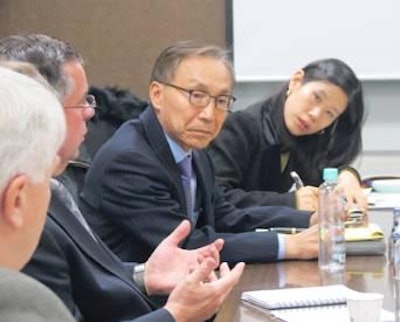
Several Illinois Soybean Association directors and staff recently traveled to Asia on a checkoff-funded mission to promote the state's transportation system and discuss ways to improve shipping the state's soybeans to customers around the world.
"The mission was uniquely focused on transportation and logistics to ensure our soybeans reach international markets competitively. Normally, we meet with processors and end-user customers during our trade missions," says Ron Kindred, soybean farmer from Atlanta, Ill., and the association’s Marketing Committee chairman.
In addition to Kindred, the group included Chairman Bill Wykes, a farmer from Yorkville, Ill.; Transportation Subcommittee Vice Chairman Paul Rasmussen, a farmer from Genoa, Ill.; Director of Issues Management and Analysis Mike Levin; and Transportation and Export Infrastructure Lead Scott Sigman.
Association representatives met with global shipping carriers at corporate headquarters in Seoul, South Korea, and Tokyo, Japan, to discuss how to better coordinate with shippers' freight needs and ensure Illinois soybeans reach overseas markets as efficiently as possible. The association is working to increase soybean utilization to 600 million bushels by 2020.
"Efficient transportation is imperative to reach our goal, so this trip was an opportunity to align with shippers. We want to make sure we provide our soybeans to them where, when and how they want them so they can deliver our soybeans to end users effectively," says Kindred.
"Our goal was to bring awareness of Illinois soybeans to these companies, and I think we accomplished that," says Wykes. "We were the first group to come speak with many of these companies about soybean shipping."
Rasmussen says the group successfully showcased Illinois transportation assets to multinational shipping companies that included STX Pan Ocean, Hanjin Shipping, Hyundai Merchant Marine, K-Line, NYK Container Line, and Mitsui O.S.K.
"Although most of the carriers have offices in the Midwest, their corporate leaders did not realize the extensive transportation network in Illinois to move bulk and containerized soybeans to nearly all U.S. ports via trucks, rail and barge," says Rasmussen.
"The representatives we met also were impressed with the checkoff-funded research we have done to improve transportation competiveness within and through the state," says Wykes. "Because containerized shipping is such a big part of their businesses, we shared study results illustrating the feasibility of moving containers of soybeans out on barges between Chicago or central Illinois and Gulf of Mexico ports."
Research conducted in 2011 pointed to container-on-barge shipping as a viable option. The association is developing a pilot program this year to test its sustainability.
According to data obtained from Informa Economics, Illinois-sourced grain and soybeans account for 66 percent of U.S. containerized exports. Currently, 15 percent of soybeans exported from Illinois are containerized, and volume is expected to continue to grow.
"The trip was definitely a success, but it is yet to be seen what the next steps will be. We have started the conversation, and will continue to be a conduit for improving efficiency throughout the supply chain to bring value back to Illinois soybean farmers," says Wykes.

















